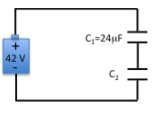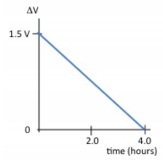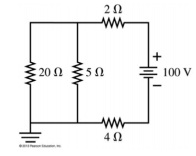Assignment:
Problems:
Problem 1 A typical nerve cell has a layer of negative charge on the inner surface of the cell wall and a layer of positive charge on the outside surface - the cell wall thus acts like a capacitor. If the cell (assumed to be spherical) has a diameter of 5.0·10-5 m and a wall thickness of 7.0 nm, and if the dielectric constant of the cell wall is 9.0, what is the capactiance of the cell? (Be sure to describe and justify any assumptions or approximations that you decide to make.)
Problem 2 A battery with an emf of 42 V is connected to the two capacitors shown in the figure at right. Afterward, the charge on capacitor 2 is 3.8· 10-4 C. What is the capacitance of capacitor 2?

Problem 3 A student does an experiment to see how long it takes for his 1.5 V flashlight battery to discharge when connected to a 6.0 Ω resistor. With a voltage meter, he measures the potential difference between the terminals of the battery and makes the plot shown at right. How much total charge passed through the resistor during this experiment?

Problem 4 Find the current through the 20 Ω resistor in the figure at right.
